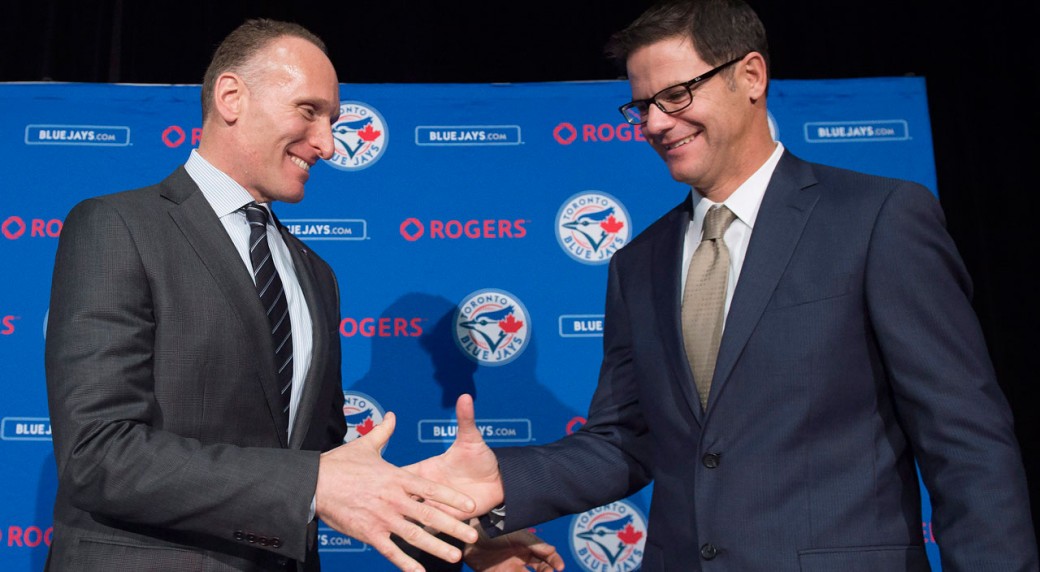TORONTO – Not since the franchise’s beginnings with Pat Gillick running the baseball side and Paul Beeston in charge of the business have the Toronto Blue Jays had the type of long-term leadership stability now in place with the extensions of Ross Atkins and Mark Shapiro.
Atkins' five-year extension announced Wednesday begins after the current season and runs through 2026, locking him in contractually for one year beyond Shapiro. Should he complete the deal, that would give the 47-year-old an 11-year run as the club’s general manager, second only to Gillick, whose 18-year run launched him toward the Hall of Fame.
Shapiro, who received a five-year extension through 2025 in January, will have run of the club for a full decade if he finishes out his deal, the longest uninterrupted stretch for a Blue Jays president and CEO, second in total years only to Day-1er Beeston.
Gillick and Beeston built an expansion team into an American League powerhouse and won consecutive World Series titles in 1992-93. Atkins and Shapiro inherited a post-season club, watched it age-out, rebuilt the organization, established a culture of their own and are now set down what they hope will be a championship path.
“It’s awesome that there’s going to be stability at the top and it trickles down all the way down to rookie ball, to the Dominican Republic,” said manager Charlie Montoyo, who himself had a 2022 club option exercised during spring training. “That’s how we felt when I was with the (Tampa Bay) Rays with the stability they have there. Everyone feels on the same page with the same group. That’s important and that’s why we’re going to be successful here. That’s why the Rays are successful.”
The deal should come as no surprise, as Shapiro said he and Atkins were engaged in active talks during an interview with Sportsnet last month. Given that the club invested $150 million over six years in George Springer over the winter, it was clear their leadership had the approval of club owner Rogers Communications Inc., which also owns this website.
Currently, J.P. Ricciardi is the second-longest tenured GM in franchise history at eight seasons (2002-09), followed by Gord Ash at seven (1995-2001) and Alex Anthopoulos at six (2010-2015). Each, for different reasons, operated on far less steady ground than Atkins, who was given the runway for both a one-toe-in-the-water attempt to keep Anthopoulos’ 2015 AL East champions going and a rebuild that led to a wild-card season in the expanded playoffs of 2020.
The messy, complicated divorces with Edwin Encarnacion, Jose Bautista, Josh Donaldson and Marcus Stroman have given way to free-agent signings like Hyun-Jin Ryu, Springer and Marcus Semien, while a young core, led by Anthopoulos parting gift Vladimir Guerrero Jr., and subsequently augmented by Atkins and Co., was developed and transitioned to the majors.
“I obviously feel extremely happy about and proud of the job he's done in building out infrastructure and, most importantly probably, acquiring and developing talent, and leading the baseball organization,” Shapiro said of Atkins last month. “I see Ross as part of a long-term future here and want him to be here, and that's shared at the ownership level.”
That it got to this point is a byproduct of stability that began in the tumult of Shapiro’s arrival at the end of the 2015 season and the departure of Anthopoulos.
Atkins was named his replacement in December 2015 on a four-year contract, hired over Tony LaCava, the assistant general named interim GM when Anthopoulos left. In 2019, Atkins received a two-year contract extension that runs through this year.
The challenge for Atkins and Shapiro is to now leverage the enviable set up they have in place, with a young core, strong major-league roster, a deep farm system and financial flexibility in the years to come. They likely have one more mega-contract to work with during the current financial cycle and they have the contractual stability to finish the build they’ve started.
“If you look at the most successful sports franchises, there are ones that react year-to-year, season-to-season on fast cycles and they're kind of perpetually spinning,” said Shapiro. “The ones that have the strength and resilience to stick with some stability and continuity, even through the down times, gives those people the ability to make adjustments because things rarely go the way that you think they're going to go. Continuity gives you the ability to course-adjust and to adapt a plan, because a plan will almost certainly have to be adapted and adjusted.
“When you turn it over, it just takes so much time to deal with a new style, a new set of values and new leadership expectations, building trust back again,” he continued. “If you look at the Pittsburgh Steelers, if you look at the San Antonio Spurs, New England Patriots, there's usually a lot of stability at the top. That's a very difficult model to maintain in professional sports, where emotion and momentum factors into so many decisions. But if you have the strength to do it, it usually is a benefit.”
Atkins and Shapiro are now in possession of the type of runway only Gillick and Beeston have had before them in Blue Jays history. Their legacy lies in what they do with it.

